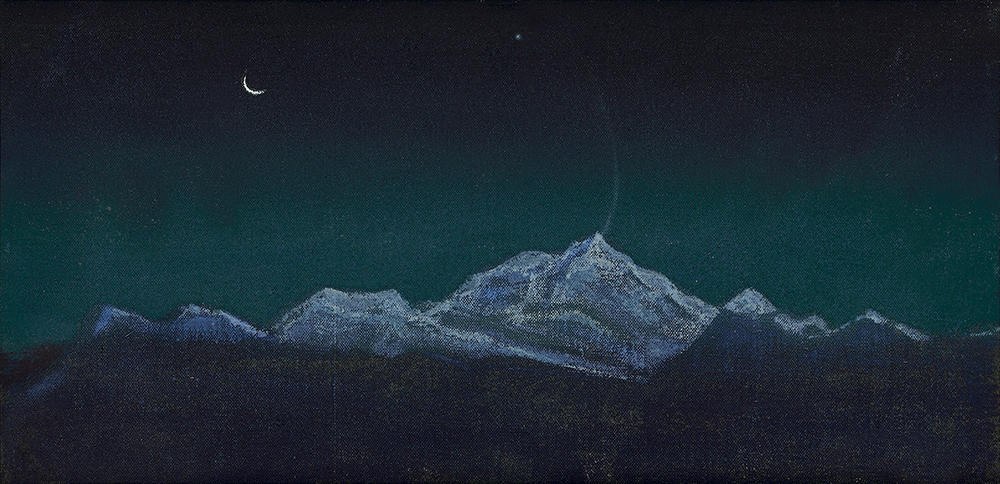 >>
>>
| Картины Н.К.Рериха |
<<  >> >>
| сменить фон |
Ссылка на изображение: http://gallery.facets.ru/pic.php?id=5659&size=3
| |
|
|
|
|
|
|
||||||||||||
|
||||||||||||
|
||||||||||||
MacDougall's 29.11.2017:
86. ROERICH, NICHOLAS (1874-1947) Himalayas, Sikkim, numbered “N 25.” and dated 1928–1929 on the reverse. Tempera on canvas, laid on cardboard, 21 by 42 cm. 10,000-15,000 GBP Provenance: Estate of Nettie and Louis Horch. Acquired from the above by a previous owner. Private collection, USA. Literature: Roerich Museum. Catalogue, New York, 1930, p. 36, No. 941, listed under years 1928–1929.
https://www.astaguru.com/biddetails.aspx?pid=3492 Modern Indian Art December 21 - 22, 2018 Lot No. - 3 Artist - Nicholas Roerich Title - Himalayas, Sikkim Medium - Tempera on canvas Year - circa 1928 - 1929 Size - 8.3 x 16.5 in. Estimate - 60,00,000 - 80,00,000 Rupees Winning Bid 80,81,832 Rupees (Inclusive of 15% Margin)
Additional Information This lot is a National Art Treasure - Non Exportable Item (payment only in Indian Rupees)
Literature : Roerich Museum. Catalogue, New York, 1930, p. 36, No. 941, listed under years 1928–1929.
Provenance : Property from a private Delhi based collection, artwork was acquired by the present owner from Macdougall Arts, London. Originally from the Estate of Nettie and Louis Horch. Nicholas Roerich Himalayas, Sikkim A man fondly remembered with titles akin to ‘Master of Mountains’ and the ‘Apostle of Culture and Peace,’ Nikolai Konstantinovich Roerich was a man of undeniable splendor. A great artist, scholar, writer and humanitarian, he enriched lives and nations with his legacy of works and inimitable ideology that till date awaits a predecessor of that stature. He was pre-eminently a symbolic painter, one who’s hues of sapphire and clandestine clouds of white will forever be etched as the most magnificent representations of the Himalayan range.
Works of this magnitude ascertain how artist such as Roerich do not just get included into renown nor were his works mere coincidences that occurred on canvas. The colour compositions, and vivid imagery were all derivatives of a mind that perceived much more than what meets the eye. His works were born from a certain sense of familiarity that he had achieved with the mountains he so admired, and the country he felt most at home in, India.
Roerich was born on October 9, 1874, in St. Petersburg, Russia. He was born to Maria and her husband, lawyer Konstantin Roerich. They had a certain social standing of the time where interactions with renowned writers, scientists, travelers and artists were a not uncommon. From a young age, Roerich showed a keen interest and skill in archaeology and would excavate parts of his backyard and areas close to home. Unearthing trinkets of eras gone by always sparked a wonder in him for mysteries of all that he was yet to learn. By the age of sixteen, he decided to join the Academy or Art and pursue art as a career, something his father was against. He considered art to be a frivolous career with no guarantees. After much ado about it, Nicholas enrolled simultaneously in the Academy of Art and at St. Petersburg University.
Roerich’s association with India however, began during his childhood, when he came across a portrait of a majestic mountain range that enthralled him. He eventually found out that it was a painting of Kanchenjunga and knew then it was where he had to be and where he would eventually trek to.
Accolades came knocking on his door as early as 1906 when he was honoured with the title of Director of the Academy for the Encouragement of Fine Arts in Russia. In 1910 he became the first President of the World or Art. Roerich had his works exhibited in London in May and exhibition tour in America the same year. By the beginning of the 20 th century, Roerich was a well established artist in most of Europe. In 1923, due to factors not within their control, namely health and rising political issues, Nicholas and his family, wife Helena and sons George and Svetoslav, left for India.
Upon arriving in India, Nicholas and his family set out to visit the vast lands, cultures and people that the country had to offer. He chanced upon meeting some of the great minds of the time like the Tagores. Roerich was instantly drawn to all the sights, sounds and experiences the country had to offer, quenching his ever longing thirst for excavating things yet to be known.
Following an expedition to the heart of Asia that spanned out between 1927 and 1929, the Roerichs eventually returned to India in 1928 and settled in the Kullu Valley in the Himalayan foothills. It was in 1928 that Roerich laid the foundation of the Uruswati Himalayan Research Institute, which was a center to study not only the Himalayas but the regions in and around them through expeditions.
Roerich was a founder of a new school of art best referred to as ‘Synthesis of Wisdom.’ His untiring effort to promote and maintain the progress of humanity was seen in the likes of his Banner of Peace Triune. He was a foreign national whose works were worthy of being considered National Art Treasure by India. |
||||||||||||

